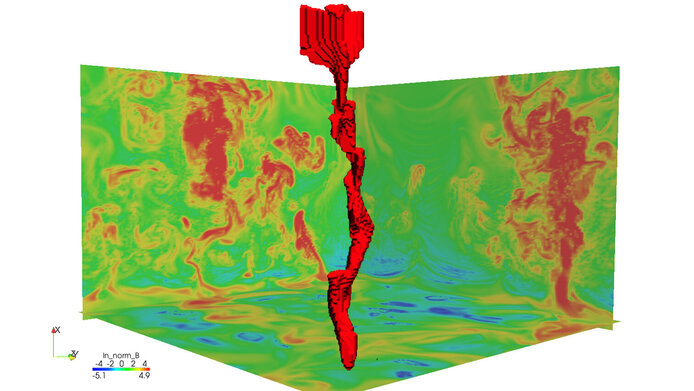New method makes space weather easier to predict

The sun’s surface is turbulent and constantly in motion: Dynamo effects create magnetic fields which, together with currents, travel outward towards the sun’s surface, thereby determining the sun’s activity. The solar activity in turn influences how much radiation reaches the earth. Long-term variations of this activity can also affect the earth’s climate.
A Flood of Data About Solar Wind
The team headed by project leader Arnold Hanslmeier is particularly interested in what are known as solar magnetic flux tubes. These flux tubes were discovered only a few years ago and are a precursor of solar flares. Hanslmeier explains: "It is believed that flux tubes form underneath the sun’s surface a few days before a solar flare erupts. Yet the forces that generate these flux tubes remain largely unknown." The team is also interested in the heating mechanisms that occur on the sun’s surface and directly affect the sun’s lower atmosphere. The methods being developed by Hanslmeier will make it possible to link data gained from high-resolution telescopic images with data generated by complex computer simulations. The conventional computation methods that are currently available are actually lagging behind the rapid development of solar telescopes and computer power, as the project leader explains: "New high-resolution solar telescopes generate such vast amounts of data that it is impossible to analyse all of the data individually. That requires automated processes – which is exactly what we are now developing. These processes will allow us to achieve unimaginable temporal and spatial resolution when computing solar dynamics. We are particularly excited about the upcoming opportunity to work with Europe’s largest solar telescope on the Canary Islands."
Segmented & Computed
More specifically, the aim of the project is to develop 2D and 3D algorithms that can calculate extremely small segments of solar magnetic flux tubes using imaging- and simulation data. This research is complemented by comparable segmentations of convective upward and downward flows of the sun’s hot plasma. Arnold Hanslmeier explains the purpose of these calculations: "Segmentation allows us to represent the solar magnetic flux tubes and convection currents as three-dimensional images. At the same time, we can observe how this three-dimensional representation evolves over time. This gives us an essential link between actual observations and theoretical simulations." For the team headed by Hanslmeier, this link is the key to gaining a better understanding of the mechanisms that lead to the formation of flux tubes and subsequently cause these flux tubes to develop into solar flares. The findings of this FWF-funded project will therefore be a vital tool for scientists to not only better understand the intensity of solar flares and solar winds, but to also detect this solar activity sooner and take the necessary precautions. In light of the threat that strong solar winds can pose for essential electric infrastructure in space and here on earth, the significance of these findings will go far beyond fundamental scientific insight.
Personal details Arnold Hanslmeier is professor of astrophysics at Karl-Franzens-Universität Graz. His research interests are solar activities, sun-like stars, exoplanets and life in the universe.





